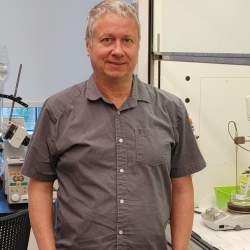
Marc Anderson
Education
B.S. (1995) University of Colorado at Boulder, Computer Science
Ph.D. (2001) University of California at Santa Cruz, Organic Chemistry
Research Areas: Organic and Medicinal Chemistry
Our group uses organic synthesis as a tool to design and optimize modulators of therapeutically relevant protein targets. Previous targets we have pursued are anion channel proteins, including: TMEM16A (anoctamin 1), UT-A, CFTR, pendrin, SLC26A3, SLC26A4, etc. Typical projects involve multi-step organic synthesis of putative small molecule channel protein modulators. When amenable, cell-based functional assays are used that investigate potency against the channel protein targets. As part of this work, frequently develop new synthetic methods for heterocyclic molecules, including coumarins, benzofurans, triazolo-thieno-pyrimidones, etc., and then generate libraries of new molecules that probe structure-activity relationships (SARs).
Download Adobe Reader to view the PDF files on this page.